|

Winter 2001 (9.4)
Baku's Architecture
Identity
of Architects and Financiers Revealed
by Farid
Alakbarov
 
While medieval
architects were lauded and studied during the Soviet period,
Azerbaijani architects from the capitalist period were ignored
and forgotten. In fact, during the Stalinist era, their names
could not even be spoken.
On a
walking tour in Baku, you're likely to see a wide variety of
buildings: stone fortresses, magnificent palatial residences
and medieval mosques as well as modern apartment buildings, modern
bank buildings and hotels. In the midst of the hustle and bustle
of modern life, there is the wonderful sensation that you are
surrounded by history.
Yet, surprisingly few Azerbaijanis know the history behind the
city's older landmarks, including the Maiden's Tower and the
magnificent mansions that were erected during the late 19th century
and early 20th century. Many of the details concerning these
buildings were hidden or distorted during the Soviet era, especially
regarding those buildings erected during the "capitalist
era", the Oil Boom that preceded Communist rule (1920-1991).
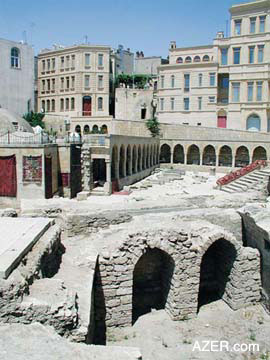  Azerbaijani historians
are now piecing together the history of Baku's architecture using
accounts and records stored in historical archives such as Baku's
Institute of Manuscripts. Here Dr. Farid Alakbarov presents some
of their recent discoveries in an era-by-era survey of Baku's
architecture. Azerbaijani historians
are now piecing together the history of Baku's architecture using
accounts and records stored in historical archives such as Baku's
Institute of Manuscripts. Here Dr. Farid Alakbarov presents some
of their recent discoveries in an era-by-era survey of Baku's
architecture.
The Maiden's Tower is one of Baku's most prominent and striking
monuments. It has a unique shape: a cylindrical, eight-story
stone tower attached to a large stone ledge, or what might be
called a "tail". From the air, you might say it looks
like a giant comma.
The origins of the Maiden Tower remain a mystery to this day.
Azerbaijani historians still debate even the most basic questions
about it, including: When was it built? What was it used for?
Why does it have such a peculiar shape?
When Soviet archeologists and historians researched the Maiden's
Tower, they identified it as a military fortress that had been
built in the 12th century by architect Masud ibn Davud, whose
name was found on a stone that had been inserted into the wall.
Later, historian Sara Ashurbeyli proved that the stone was merely
a broken tombstone that had been used to repair the tower. Most
likely, Masud ibn Davud wasn't even an architect and had no relation
to the tower.
Above: View at the back of
Maiden's Tower with its archeological layers juxtaposed with
the newer and refurbished examples of architecture that have
been cropping up this past decade in the Old City.
After Azerbaijan gained its independence (late 1991), architectural
historian Shamil Fatullayev wrote in his "Architectural
Encyclopedia of Baku" (1998) that the tower dated back at
least 1,300 years ago to the pre-Islamic period.
Professor Davud Akhundov has developed another striking theory.
He believes that the tower was never used for military purposes
but rather served as an ancient Zoroastrian fire-worshipping
temple. Akhundov writes in his book "Architecture of Ancient
and Early Medieval Azerbaijan" (1986, Baku, p. 287): "At
the beginning of the 1st millennium BC, there was raised an eight-storied
towered temple (Maiden's Tower), devoted to seven Gods, grandiose
for those days: there were seven sacred levels, wall recessed
altars with seven-colored fires burning in honor of the Pantheon
of Gods of Ahura Mazda or Mithra."
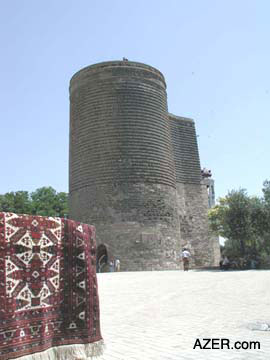  While no one knows for
certain why the Maiden's Tower was built, we now know that it
was not built in the 12th century, but rather many centuries
earlier. While no one knows for
certain why the Maiden's Tower was built, we now know that it
was not built in the 12th century, but rather many centuries
earlier.
Shirvanshah Palace
The medieval Shirvanshah Palace is an important symbol for Azerbaijanis,
as it reminds them of Azerbaijan's history as an independent
state. Some chauvinist academics in the USSR tried to prove that
Azerbaijan never had its own state but was ruled by other nations
like Russia and Persia up until 1918. In fact, some misinformed
Azerbaijanis and foreigners continue to believe this today. However,
all of the historical evidence, including this Palace, proves
that Shirvan (Northern Azerbaijan) was an independent state for
700 years, from the 9th century to the 16th century.
The Palace in Baku was erected in the 15th and 16th centuries
by the Shirvanshahs, the rulers of the Shirvan state. It was
the only large ancient palace in Azerbaijan that was not destroyed
by invaders during the Middle Ages. Within the Palace complex,
there is a two-story main building, which once held an elaborate
gold-plated throne. In front of the main building stands the
mausoleum of 15th-century scholar Seyid Yahya Bakuvi. A nearby
building called the Divankhana (Court of Law) features portals
that are adorned with beautiful stone carvings. The lower yard
of the Palace contains the burial vault of the Shirvanshahs as
well as a mosque and the remains of an ancient bathhouse.
Above: Historians are still
debating the mysterious origins of the Maiden's Tower, one of
Baku's most familiar landmarks.
The Shirvanshah Palace was not used as an actual palace for long.
In the 16th century, Baku was captured by Shah Ismayil Safavi
from the city of Ardabil in Southern Azerbaijan [now Iran]. He
completely conquered the Shirvan state, killed the ruling shah
dynasty and burned some of the buildings of the Shirvanshah Palace
complex.
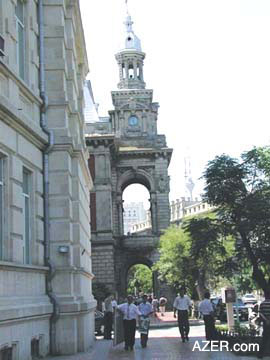  In the 19th century,
Russian soldiers used the Palace's main building as barracks.
One of the two mosques was used as a military arsenal, which
exploded in 1918. Today only one mosque remains on the Palace
grounds. In the 19th century,
Russian soldiers used the Palace's main building as barracks.
One of the two mosques was used as a military arsenal, which
exploded in 1918. Today only one mosque remains on the Palace
grounds.
During the Soviet period, the Shirvanshah Palace was used as
a Museum. Today, the Museum and its buildings are closed, and
the Palace is under extensive renovation. Unfortunately, a lack
of financing has brought this reconstruction to a halt.
Pre-Soviet Architects
Medieval Azerbaijani architects were relatively well researched
during the Soviet period. One of the most distinguished was 12th-century
architect Ajami ibn Abubakir, sometimes known simply as Ajami
Nakhchivani. Recently, a Metro station in Baku was named in honor
of him. Ajami Nakhchivani erected a large, tower-shaped mausoleum
in Nakhchivan that is decorated with stone carvings and glazing.
He built the mausoleum in 1186 in honor of Momine Khatun, the
wife of Sultan Muhammad Jahan Pahlavan of the Eldaniz dynasty,
who ruled Southern Azerbaijan and Nakhchivan. Ajami Nakhchivani
was also known for building the Yusuf ibn Kuseyir Mausoleum in
Nakhchivan.
Other important Azerbaijani architects from the 13th and 14th
century include Zeynalabdin Shirvani, Mahmud ibn Magsud, Abdul
Momin Tabrizi, Jamaladdin, Haji Alishah Tabrizi, Omar, Nizam
Tabrizi, Tajaddin and Arif. Historians of the Soviet period researched
famous 13th-century Baku architects like Abdul Majid, who built
the Mardakan Tower, and Mahmud ibn Saad, who built the Nardaran
Tower in the vicinity of Baku. We also know that Azerbaijani
architects and builders participated in the construction of the
Taj Mahal in India and many other architectural projects in Central
Asia and the East.
Above: Bak Sovet which serves
as the Mayor's office was built in 1900-1904.
While these medieval architects were lauded and studied during
the Soviet period, Azerbaijani architects from the capitalist
period were ignored and forgotten. In fact, during the Stalinist
era, their names could not even be spoken.
Once Azerbaijan became independent, scholars like Shamil Fatullayev
researched the work of talented architects from the late 19th
and early 20th centuries. Fatullayev issued his "Architectural
Encyclopedia of Baku" in 1998, highlighting the work of
long-forgotten architects like Gasim Hajibababeyov, Mashadi Mirza
Gafar Ismayilov, Zivar Ahmadbeyov, G. Akhundov, Omar Abuyev,
Ismayil Gajar and Mirza Hasan Hajinski.
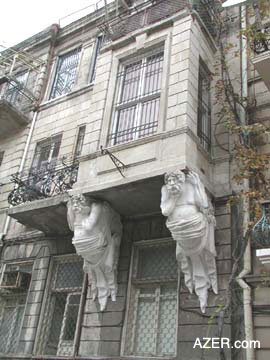  During the Soviet period,
however, Russian architects received all of the credit for rebuilding
and modernizing the medieval fortress - city of Baku. Granted,
when Baku became the capital of the Baku Province of the Russian
Empire in 1859, Russian architects did introduce new Western
architectural styles there, such as Baroque, Gothic, Renaissance,
Modern and Mauritanian. During the Soviet period,
however, Russian architects received all of the credit for rebuilding
and modernizing the medieval fortress - city of Baku. Granted,
when Baku became the capital of the Baku Province of the Russian
Empire in 1859, Russian architects did introduce new Western
architectural styles there, such as Baroque, Gothic, Renaissance,
Modern and Mauritanian.
However, Azerbaijani builders also contributed significantly
to this work. Most of the planning and construction activities
were carried out by Gasim Hajibababeyov (1811-1874) and Mashadi
Mirza Gafar Ismayilov. From 1862 to 1867, Hajibababeyov built
up the coastal region of central Baku, which is now considered
the most beautiful part of the city. He founded the coastal park,
created a water supply system and built numerous fountains. He
also developed the plan for the shaded Tsitsianov Garden, one
of the central parks of Baku.
Hajibababeyov designed the central square of the city - the Parapet,
now known as Fountain Square. In 1868, he built a large caravanserai
near this square; it is now the Araz movie theater.
Russian, Polish and German architects such as Goslavski, Ploshko,
Eichler and Von Der Nonne also played an important role during
the pre-Soviet period, erecting a number of architectural masterpieces
in Baku, including the Baku City Hall, the Mukhtarov Palace,
the Taghiyev Palace and the Ismailiyya Palace.
Above:
Many names
of the owners and architects have long been forgotten as it was
dangerous to talk about capitalists during the Soviet Period.
Oil Barons
Many of the magnificent buildings that were built in the late
19th century and early 20th century were funded by Azerbaijan's
first major Oil Boom. However, the businessmen and oil barons
who built these buildings were rarely mentioned during the Soviet
period. Before Azerbaijan became independent, many of its citizens
had no idea who had built the grandiose houses that line the
streets of Baku.
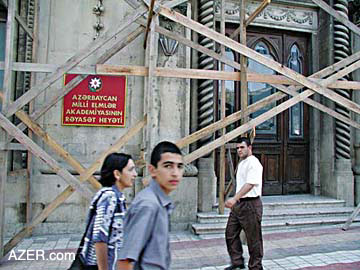  Azerbaijani businessmen
and philanthropists such as Taghiyev, Naghiyev, Asadullayev,
Mukhtarov, Ashurbeyli and Guliyev may have changed the face of
Baku's architecture, but their efforts were scorned during the
Soviet period. It wasn't "politically correct" to mention
them. Historians wrote that the capitalists in Baku built luxury
palaces while the workers and peasants lived in poverty and suffered
from hunger and disease. Azerbaijani businessmen
and philanthropists such as Taghiyev, Naghiyev, Asadullayev,
Mukhtarov, Ashurbeyli and Guliyev may have changed the face of
Baku's architecture, but their efforts were scorned during the
Soviet period. It wasn't "politically correct" to mention
them. Historians wrote that the capitalists in Baku built luxury
palaces while the workers and peasants lived in poverty and suffered
from hunger and disease.
Left: Many of Baku's prominent
government buildings, such as the Academy of Sciences, have recently
undergone reconstruction.
Usually, these historians did not reveal that the oil barons
had also built schools, libraries and hospitals to help the poor.
If these deeds were mentioned, they fell into the category of
"the hypocrisy of the ruling class." While oil barons
made a huge profit out of the workers' labor, the Soviet historians
said, they paid out only a tiny portion of the income in the
form of salaries and philanthropy projects.
Haji Zeynalabdin
Taghiyev
Oil baron and philanthropist Haji Zeynalabdin Taghiyev constructed
numerous buildings in Baku, including the opulent Taghiyev Residence,
which now houses the National History Museum. The Taghiyev Residence
was constructed in 1893-1902 by Polish architect Joseph V. Goslavski
(1865-1904) and occupies an entire city block. Due to damage
that was sustained from Baku's earthquake last year, the building
is currently closed for repairs.
Taghiyev worked to provide education for poor Azerbaijanis and
women. With this purpose in mind, he built a beautiful boarding
school for Muslim girls in the central part of Baku in 1898.
This three-story, Mauritanian-style building was the first girls'
school in the Muslim East. Goslavski was the architect of this
Taghiyev-funded building as well.
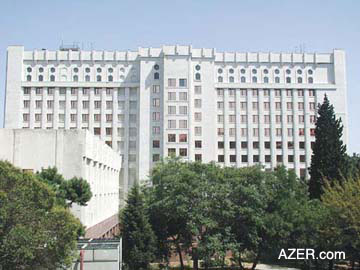  Not everyone appreciated
Taghiyev's efforts, however. Though Taghiyev had secured the
approval of Russian Czar Alexander III, some Muslim extremists
in Baku tried to stop the school from being built. Not everyone appreciated
Taghiyev's efforts, however. Though Taghiyev had secured the
approval of Russian Czar Alexander III, some Muslim extremists
in Baku tried to stop the school from being built.
During Perestroika, material related to these events began to
surface. It turns out that the fanatics entered the home of Mulla
Ruhulla, a friend of Taghiyev who sent his daughters to the school,
and killed him while he was praying. Religious extremists gathered
in the street and attacked unveiled Azerbaijani women, forcing
them to take off their European shoes and put on the black veil
[chador]. The schoolgirls and their parents were terrified.
Following the advice of Taghiyev, the schoolgirls wrote a letter
to Russian Empress Alexandra Feodorovna, thanking her for the
permission to open the school. In a telegram, the Empress replied
that she hoped the girls would become useful and happy citizens
of their native land. After this reply, the fanatics became afraid
of inciting the government and did not attack the girls anymore.
The school took on the name, "Alexandrian Russian Muslim
Female Boarding School."
Above: The President's Aparat
was constructed by Heydar Aliyev in the late 1970s.
During Azerbaijan's early independence period (1918-1920), Taghiyev
presented the school building to the Azerbaijan Democratic Republic
(ADR) government. Later, the Bolshevik Parliament functioned
there. Today, this beautiful building houses the Institute of
Manuscripts.
  Taghiyev also financed
the construction of the Music Comedy Theater, the first European-style
theater to be built in the Muslim East. Many of Hajibeyov's operas
were performed in this theater. However, during the Soviet period,
Azerbaijanis avoided mentioning that Taghiyev had built the theater
- it was too dangerous. Now, the theater has been renovated and
has become even more beautiful. Taghiyev also financed
the construction of the Music Comedy Theater, the first European-style
theater to be built in the Muslim East. Many of Hajibeyov's operas
were performed in this theater. However, during the Soviet period,
Azerbaijanis avoided mentioning that Taghiyev had built the theater
- it was too dangerous. Now, the theater has been renovated and
has become even more beautiful.
Agha Musa Naghiyev
Another oil baron who contributed greatly to Baku's architecture
was Agha Musa Naghiyev (1849-1919). He built the Ismailiyya Palace,
one of the most beautiful buildings in Baku, for the city philanthropic
association "Jamiyyati-Kheyriyya". The building was
named in honor of Naghiyev's son Ismayil, who died in his youth
of tuberculosis.
Naghiyev hired Polish architect I. K. Ploshko, who suggested
that he build Ismailiyya in the Venetian Gothic style. The construction
was finished in 1913, but five years later, Ismailiyya was burned
by Armenian Dashnaks. Azerbaijanis repaired it and placed the
ADR Parliament there in 1919. To force the Parliament to capitulate
the following year, the Bolsheviks opened fire on the Palace
from nearby ships. Fortunately, the building was not destroyed.
During the early Soviet period, Bolsheviks removed the quotations
from the Koran from the facade of Ismailiyya and replaced them
with Communist slogans and golden stars. When the Academy of
Sciences moved there, the words "Academy of Sciences of
the Azerbaijan SSR" were inscribed along the top of the
façade. The large metallic golden stars and letters that
were attached to the building as ornamentation have not been
removed, though the name of the building near its entrance is
now written in Azeri Latin script and English.
Above: Modern Seaview Plaza
near Narimanov Square.
Even though Naghiyev was considered to be one of the wealthiest
oil barons in Baku, he had a reputation among his peers for being
somewhat of a miser. For instance, he carefully supervised the
construction work at his building sites. He would keep a close
eye on his employees and their work, to the point of opening
boxes of nails to count all of them himself.
According to the late writer Manaf Suleymanov, one winter Naghiyev
visited a construction site around lunchtime. He saw his contractor
and some of the construction laborers gathered around the fire
eating lunch. The contractor struck a match and lit a cigarette.
Naghiyev looked at him and said: "Don't come to work tomorrow.
Go to the office and get your discharge ticket."
"Why, Agha Musa?" asked the contractor in desperation.
"There's a big fire in front of you, but yet you struck
a match and used it even though it wasn't necessary. If you don't
care about your own property, how can I trust you to take care
of mine?" Naghiyev is said to have replied.
Even though he was known for being a miser, Naghiyev was also
a philanthropist who financed several important buildings and
projects. For instance, he built a huge hospital, which now,
since independence, bears his name - the Musa Naghiyev First
Aid Hospital. He also helped finance the construction of Baku's
water supply system - the Shollar Water Works. He helped to build
several schools in Baku and covered the expenses for 25 Azerbaijani
schoolboys who were from poor families.
During the Soviet period, Naghiyev's contribution to Baku's architecture
was almost forgotten. His contributions became valued only after
Perestroika and independence.
Murtuz Mukhtarov
Baku's Wedding Palace, one of the largest mansions in the center
of the city, was once the luxurious residence of oil baron Murtuz
Mukhtarov (1855-1920). After a visit to Europe, Mukhtarov decided
to build a residence for himself in the style of a French Gothic
palace. Polish architect I. K. Ploshko oversaw the construction
of the mansion in 1911-1912.
Mukhtarov also built the Amirjan Mosque, the largest mosque of
Azerbaijan, located in Amirjan, a suburb of Baku. The Russian
government did not allow him to build such a large mosque in
the center of Baku. Mukhtarov also erected a large mosque in
the city of Vladikavkaz in the North Caucasus. Today, Mukhtarov's
huge countryside villa is being used to house the offices of
the Baku Botanical Garden.
Agha Bala Guliyev
In 1899, Agha Bala Guliyev constructed a beautiful palace in
the center of Baku. In contrast to the various European styles
that his fellow oil barons were using, Guliyev chose to build
his house in the Baku-Absheron architectural style, incorporating
decorations from the portals of the Shirvanshah Palace. His is
the only oil baron residence that was built in this style. Polish
architect Skibinski designed the residence.
Few Azerbaijanis are aware that Guliyev, known as a flour baron,
initiated an early pipeline project for the transportation of
Caspian oil to the port of Batum [Georgia] on the shores of the
Black Sea. He founded the Baku-Batum joint-stock company and
began to build the pipeline in 1897, finishing the work in 1907.
Lost Murals
The halls, ceilings and doorways of the oil baron palaces were
filled with colorful, oil-painted murals. These paintings included
various pastoral landscapes, flowers, animals, as well as traditional
Muslim ornaments, scenes from the Bible and pictures of daily
life from the late 19th and early 20th century.
During the early Soviet period, the Bolsheviks painted over or
destroyed thousands of these murals because they were considered
to be "capitalist architectural extravagances." In
many cases, they also tore down the beautiful molding, volutes
and scrollwork found inside many of the buildings. They stipulated
that a building should be as simple and modest as a worker's
life.
Only a few of the original interiors remain intact, including
a room and hall in the Ismailiyya Palace and the Oriental Hall
of the Taghiyev Palace. Today, it would be impossible to restore
all of the paintings that were destroyed during the 70 years
of Soviet rule. Some old photos and rare examples of artwork
still survive, but that is all that exists today.
Stalinist Period
Up until 1953, Soviet propaganda suggested that Azerbaijan's
great architectural achievements were created under the leadership
of "the Father of Nations" - Stalin. Certainly, many
impressive, beautiful buildings were built during Stalin's rule.
These include the Baku Railway Station, built during the early
Soviet period using traditional Azerbaijani architectural forms.
Consider also the great Government House of Azerbaijan in Lenin
Square (now Independence Square), built by architects L. Rudnev,
V. Munts and K. Tkachenko at the end of World War II. Captured
German soldiers served as part of the workforce, leading the
people of Baku to say: "This building is of high quality
because the German soldiers built it. They are so precise and
accurate!"
Azerbaijan's most famous architects during the Stalinist period
were Sadikh Dadashev and Mikayil Useynov. They created masterpieces
like the huge "Buzovnineft" building in Nizami Street,
Academy of Sciences of Azerbaijan, Nizami Cinema, Hajibeyov Conservatory
[now the Music Academy], Nizami Museum, Cabinet of the House
of Ministers and Akhundov National Library. Majidov built the
huge Lenin Museum [which now houses the Carpet Museum]. Azerbaijani
architects Alizade and Madatov constructed the Azerbaijan Dramatic
Theater. Despite the fact that some of these buildings were completed
during the Khrushchev period, they continue to be known as "Stalin's
Buildings" ("Stalinkas" in Soviet slang), owing
to their large size, magnificence and beauty.
During Stalin's era, a new type of building began to appear in
Azerbaijan: the so-called Palace of Culture. The Palace was a
special theater where workers and others went to be entertained
by plays, lectures, chess matches, sports competitions and concerts
of folk or Soviet music. Many of these imposing Palaces of Culture
resembled ancient Greek temples like the Parthenon.
In the 1920s, the Bolsheviks worked to create city gardens for
workers. The Sabir garden adjacent to the Presidium of the Academy
of Sciences was created, and the seashore boulevard was rebuilt
and extended. Many of these gardens were filled with statues,
including monuments to Marx, Lenin, Engels and Stalin as well
as to great Azerbaijani poets and writers.
Not all of these statues were aesthetic from a modern point of
view. Huge plaster and bronze figures of the Worker Man and the
Peasant Woman served as larger-than-life reminders of Communist
ideals. The man held a large hammer, and the woman, a sickle,
symbolizing the union between the workers and peasants of the
Soviet Union. Both figures were athletic and muscular, with impassive,
robot-like faces. Other statues depicted sportsmen and sportswomen
with the slogan: "Don't be stupid, go out for sports!"
Of course, after independence, all of these statues were dismantled.
Living conditions during Stalin's rule were far from ideal. Most
Soviet citizens had to live together in communal apartments with
shared kitchens, toilets and bathrooms. Stalin's policy was to
force different people to live together as a single family.
Once Azerbaijan became independent, historians could write freely
about both the merits and shortcomings of the Stalinist period
of architecture. The Stalinist tendency to construct huge administrative
buildings is now considered a form of megalomania. On the other
hand, scholars do agree that many high-quality, beautiful buildings
were built in Baku during the Stalinist period.
Khrushchev Period
When Khrushchev came to power, he denied all of the achievements
of the Stalinist period of architecture. He declared that all
250 million Soviet people should have their own separate (as
opposed to communal) apartments. To achieve this goal in a short
period of time, houses were built very quickly with cheap materials;
zero attention, it seems, was directed to quality and aesthetics.
These ugly five-story buildings - "Khrushchovkas",
meaning "Khrushchev's home" in Soviet slang - are still
standing in Baku today. Sometimes people call these houses "Khrushoba",
a combination of the Russian "trushoba" (poor, dirty
hole) and the surname Khrushchev.
When these cheap apartments were built, Khrushchev said: "Don't
worry, these are only temporary homes! In 25 years, once the
Soviet Union is the richest country in the world, these buildings
will be torn down and replaced by real palaces for the working
people."
Even though these buildings were very poor in quality, Khrushchev's
project was depicted as a great victory for Socialism. We now
see these buildings for what they really are, but we must also
remember that they enabled thousands of Azerbaijanis to leave
the Stalinist communal homes and have their own apartments at
last.
Brezhnev Period
According to Brezhnev, Khrushchev's attempt to provide all citizens
with separate apartments in such a short period of time was "voluntarism"
- that is, the aspiration to achieve unreal things. Brezhnev
stopped building these cheap and ugly Khrushchovkas in Baku.
Instead, five- and nine-story buildings of a much better quality
were erected throughout the Republic. Heydar Aliyev, Azerbaijan's
leader at the time, launched large construction projects such
as the Gulistan Palace, the Republican Palace, the Exhibition
of the People's Industry Achievements, the Central Committee
of the Communist Party and the Parliament House.
The Absheron and Azerbaijan Hotels went up near the Government
House and Lenin Square. The Moscow Hotel also became famous as
a place where wealthy foreigners from Europe stayed.
In general, the Stalinist style was replaced by more modern architectural
forms. The old Parapet was turned into Fountain Square, with
numerous fountains and sculptures.
At the time, Azerbaijani books and newspapers emphasized the
role of the Communist Party in beautifying Baku. Brezhnev himself
repeatedly visited the city and said: "Baku is a beautiful
city. It is a pleasure to live and work in this city!" His
words soon appeared as a slogan on Baku billboards.
Despite all of these achievements, Azerbaijani architecture suffered
from the same problems that plagued the entire Soviet Union.
Now that Azerbaijani is independent, we may freely write that
the dwellings built during the Brezhnev era were also of comparatively
poor quality. This was related to the corruption that spread
throughout the Soviet building industry. Usually, the people
who lived in a new house were forced to repair it themselves
because it had been built so poorly.
New Developments
The architecture of Baku has changed significantly since Azerbaijan
became independent in 1991. The international companies that
have signed oil contracts in Azerbaijan brought with them a huge
stream of investment. Many have chosen to situate their offices
in the center of the city, some even in the medieval Inner City
(Ichari Shahar). To reflect Baku's architectural environment,
many of the new offices are being built in the traditional Eastern
style and resemble medieval houses. Some of the older houses
in the Inner City are being refurbished, giving the historic
center of Baku a much cleaner, updated look.
Nevertheless, many Azerbaijani architects are strongly against
the new construction that is going on in the Inner City. They
believe that the extensive building that is taking place there
infringes upon the unique structure of the medieval city. Even
though the walled Inner City, including the Maiden's Tower and
Shirvanshah Palace, has had UNESCO World Heritage Site status
since 2000, measures to protect it are either not in place or
difficult to enforce.
During the Soviet period, Baku wasn't exactly known for its comfortable,
luxurious hotels. But now that there are a significant number
of foreigners in the city, new hotels have been constructed.
Two examples include the tall buildings of the Europe Hotel and
the ISR Plaza. The old Nakhchivan Hotel has been reconstructed
and is known today as the Hyatt Regency Hotel and Hyatt Towers;
offices as well as residential apartments have been developed
in the Hyatt complex.
Baku's skyline has also seen the striking addition of steel and
glass buildings, such as the National Bank of Azerbaijan and
the Construction Bank. These modern buildings distinguish Baku
from other Caucasian cities such as Tbilisi and Yerevan, which
have retained much of their Soviet appearance.
A Turkish influence is visible in the apartments that are rapidly
being built and the new mosques that have recently appeared in
Baku. These mosques are designed according to the Ottoman style,
in contrast to the traditional Azerbaijani style. Usually, Ottoman
mosques have slender, spear-headed minarets and a large cylindrical
hall; a good example of this style is the famous Hagia Sophia
[Aya Sofya or St. Sophia] mosque in Istanbul. Baku's most distinguished
Ottoman-style mosque is the Turkish Juma [Friday Mosque], which
was built several years ago near Martyr's Alley.
Azerbaijan-style mosques are traditionally made of limestone
and have wider, shorter minarets. Instead of glazed or painted
roofs, the minarets each have a simple row of ornaments and quotations
from the Koran carved in stone below the balcony. The 10th-century
Muhammad Mosque in Baku is a bright example of this style.
Due to the presence of so many foreigners, new shops and stores
are also being constructed throughout Baku. Western-style supermarkets
are replacing the old Soviet stores. One of the first of these
to appear in Baku was Ramstore, which now has a chain of stores
throughout the city.
Many new restaurants, cafes and countless wedding palaces [restaurants
specializing in weddings] are being opened in Baku as well. All
of these buildings have added new features to the more traditional
appearance of Baku.
Farid Alakbarov,
a frequent contributor to Azerbaijan International, is chief
scientific officer for the Institute of Manuscripts' Department
of Arabic Manuscripts. To read other articles by Farid, SEARCH
at AZER.com. Also, several of his
articles may be found in Azeri Latin at AZERI.org.
For more information about Azerbaijan's architecture, see the
Winter 1998 issue of Azerbaijan International (AI 6.4), entitled
"Architecture and Development." Other resources about
Azerbaijan's architecture include: "The Architecture of
Ancient and Early Medieval Azerbaijan" by Davud Akhundov
(1986); "Architecture of Azerbaijan from the 19th to Early
20th Century" by Shamil Fatullayev (1988); "The Architecture
of Soviet Azerbaijan" by R. M. Afandizade (1986) and "Town
Planning in Azerbaijan (13th-16th Centuries AD)" by V. G.
Muradov (1984).
____
From Azerbaijan
International
(9.4) Winter 2001.
© Azerbaijan International 2002. All rights reserved.
Back to Index
AI 9.4 (Winter 2001)
AI Home
| Magazine
Choice
| Topics
| AI Store | Contact us
Other Web sites
created by Azerbaijan International
AZgallery.org | AZERI.org | HAJIBEYOV.com
|








